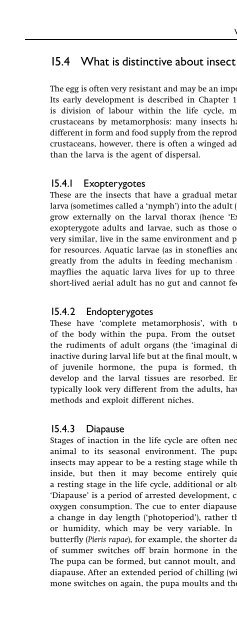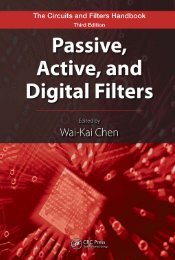An Introduction to the Invertebrates, Second Edition - tiera.ru
An Introduction to the Invertebrates, Second Edition - tiera.ru
An Introduction to the Invertebrates, Second Edition - tiera.ru
You also want an ePaper? Increase the reach of your titles
YUMPU automatically turns print PDFs into web optimized ePapers that Google loves.
WHAT IS DISTINCTIVE ABOUT INSECT LIFE CYCLES?20115.4 What is distinctive about insect life cycles?The egg is often very resistant and may be an important resting stage.Its early development is described in Chapter 19. Very often <strong>the</strong>reis division of labour within <strong>the</strong> life cycle, made possible as inc<strong>ru</strong>staceans by metamorphosis: many insects have a feeding larvadifferent in form and food supply from <strong>the</strong> reproductive adult. Unlikec<strong>ru</strong>staceans, however, <strong>the</strong>re is often a winged adult, and this ra<strong>the</strong>rthan <strong>the</strong> larva is <strong>the</strong> agent of dispersal.15.4.1 ExopterygotesThese are <strong>the</strong> insects that have a gradual metamorphosis from <strong>the</strong>larva (sometimes called a ‘nymph’) in<strong>to</strong> <strong>the</strong> adult (‘imago’). Wing budsgrow externally on <strong>the</strong> larval thorax (hence ‘Exopterygota’). Manyexopterygote adults and larvae, such as those of cockroaches, lookvery similar, live in <strong>the</strong> same environment and presumably competefor resources. Aquatic larvae (as in s<strong>to</strong>neflies and dragonflies) differgreatly from <strong>the</strong> adults in feeding mechanism and appearance. Inmayflies <strong>the</strong> aquatic larva lives for up <strong>to</strong> three years and <strong>the</strong> veryshort-lived aerial adult has no gut and cannot feed at all.15.4.2 EndopterygotesThese have ‘complete metamorphosis’, with <strong>to</strong>tal reorganisationof <strong>the</strong> body within <strong>the</strong> pupa. From <strong>the</strong> outset <strong>the</strong> larva contains<strong>the</strong> <strong>ru</strong>diments of adult organs (<strong>the</strong> ‘imaginal discs’). These remaininactive during larval life but at <strong>the</strong> final moult, when, in <strong>the</strong> absenceof juvenile hormone, <strong>the</strong> pupa is formed, <strong>the</strong> adult <strong>ru</strong>dimentsdevelop and <strong>the</strong> larval tissues are resorbed. Endopterygote larvaetypically look very different from <strong>the</strong> adults, have different feedingmethods and exploit different niches.15.4.3 DiapauseStages of inaction in <strong>the</strong> life cycle are often necessary <strong>to</strong> match ananimal <strong>to</strong> its seasonal environment. The pupa of endopterygoteinsects may appear <strong>to</strong> be a resting stage while <strong>the</strong>re is great activityinside, but <strong>the</strong>n it may become entirely quiescent and providea resting stage in <strong>the</strong> life cycle, additional or alternative <strong>to</strong> <strong>the</strong> egg.‘Diapause’ is a period of arrested development, characterised by lowoxygen consumption. The cue <strong>to</strong> enter diapause is most frequentlya change in day length (‘pho<strong>to</strong>period’), ra<strong>the</strong>r than in temperatureor humidity, which may be very variable. In <strong>the</strong> cabbage whitebutterfly (Pieris rapae), for example, <strong>the</strong> shorter day length at <strong>the</strong> endof summer switches off brain hormone in <strong>the</strong> final larval stage.The pupa can be formed, but cannot moult, and <strong>the</strong>refore goes in<strong>to</strong>diapause. After an extended period of chilling (winter) <strong>the</strong> brain hormoneswitches on again, <strong>the</strong> pupa moults and <strong>the</strong> butterfly emerges.











